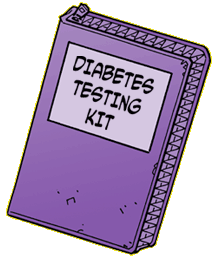UNDER THE MICROSCOPE

HYPER/HYPO GLYCEMIA
Diabetes causes high blood sugar, also known as hyperglycemia (hi-per-gly-SEE-me-uh). Because we now know a lot about the disease, and since there are lots of different medicines to treat it, most people with diabetes can keep their blood sugar pretty well controlled. But, sometimes a diabetics' blood sugar gets too low - and that can be really scary, and sometimes it can be really serious. Let's look under the microscope to see how this happens, and what to do.
 Low blood sugar is called hypoglycemia (hi-poe-gly-SEE-me-uh). This can happen when someone with diabetes doesn't eat enough, takes too much medicine, or gets too much exercise. Symptoms of low blood sugar include sweating, shakiness, and confusion, and in extreme cases, a person can faint or have a seizure. A person with diabetes who has low blood sugar needs to eat sugar - and fast - to get it under control. In fact, many people with diabetes keep glucose pills with them in case they get low blood sugar. But, if you are around someone who has diabetes and starts to feel this way, you can also help him or her out by knowing what else he or she can eat. Good options include a couple of hard candies or gumdrops, orange juice, soda or pop (not diet!), a spoonful of honey, or some cake icing. Low blood sugar isn't an excuse to gorge on sweets, though - most people with diabetes only need a little sugar to get themselves back on track.
Low blood sugar is called hypoglycemia (hi-poe-gly-SEE-me-uh). This can happen when someone with diabetes doesn't eat enough, takes too much medicine, or gets too much exercise. Symptoms of low blood sugar include sweating, shakiness, and confusion, and in extreme cases, a person can faint or have a seizure. A person with diabetes who has low blood sugar needs to eat sugar - and fast - to get it under control. In fact, many people with diabetes keep glucose pills with them in case they get low blood sugar. But, if you are around someone who has diabetes and starts to feel this way, you can also help him or her out by knowing what else he or she can eat. Good options include a couple of hard candies or gumdrops, orange juice, soda or pop (not diet!), a spoonful of honey, or some cake icing. Low blood sugar isn't an excuse to gorge on sweets, though - most people with diabetes only need a little sugar to get themselves back on track.
- Page last reviewed: May 9, 2015
- Page last updated: May 9, 2015
- Content source:



 ShareCompartir
ShareCompartir